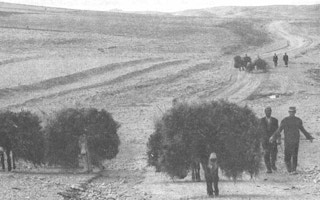Scientists looking at what is known as the “Fertile Crescent” of ancient Mesopotamia have found new evidence that drought caused by climate change brings an end to civilisations.
It is the latest study that confirms the threat posed to present civilisations in Africa, Asia and parts of the United States by changes in rainfall pattern that could lead to the abandonment of once-fertile areas − and the cities that once were fed by them.
The focus of research by a team from Tübingen University, Germany, is the area currently part of Iraq and the Persian Gulf where the development of ancient agriculture led to the rise of large cities.
Evidence from grain samples up to 12,000 years old shows that while the weather was good, the soil fertile and the irrigation system well managed, civilisation grew and prospered. When the climate changed and rainfall became intermittent, agriculture collapsed and the cities were abandoned.
“
Geographic factors and technologies introduced by humans played a big role and influenced societies’ options for development, as well as their particular ways of dealing with drought
Dr Simone Riehl, of the Institute for Archaeological Sciences and the Senckenberg Center for Human Evolution and Palaeoenvironment at Tübingen University
Analysed grains
Dr Simone Riehl, of the Institute for Archaeological Sciences and the Senckenberg Center for Human Evolution and Palaeoenvironment at Tübingen University, analysed grains of barley up to 12,000 years old from 33 locations across the Fertile Crescent to find out if they had had enough water while growing and ripening.
The 1,037 ancient samples were between 12,000 and 2,500 years old. They were compared with modern samples from 13 locations in the former Fertile Crescent.
Dr. Riehl and her team measured the grains’ content of two stable carbon isotopes.
When barley grass gets insufficient water while growing, the proportion of heavier carbon isotopes deposited in its cells will be higher than normal. The two isotopes 12C and 13C remain stable for thousands of years and can be measured precisely – giving Riehl and her colleagues reliable information on the availability of water while the plants were growing.
They found that many settlements were affected by drought linked to major climate fluctuations. “Geographic factors and technologies introduced by humans played a big role and influenced societies’ options for development, as well as their particular ways of dealing with drought,” Riehl says.
Her findings indicate that harvests in coastal regions of the northern Levant, at the eastern end of the Mediterranean Sea, were little affected by drought. But further inland, drought led to the need for irrigation or, in extreme cases, abandonment of the settlement.
The findings give archaeologists clues as to how early agricultural societies dealt with climate fluctuations and differing local environments. “They can also help evaluate current conditions in regions with a high risk of crop failures,” Riehl adds.
The study is part of a project, backed by the German Research Foundation, looking into the conditions under which Ancient Near Eastern societies rose and fell.
Scientists carrying out similar research in the Indus Valley, in present Pakistan and north-west India, home to the Harappan Civilisation, also believe that drought was the cause of the civilisation’s demise.
It was characterised by large, well-planned cities with advanced municipal sanitation systems and a script that has never been deciphered. But the Harappans seemed to slowly lose their urban cohesion, and their cities were gradually abandoned.
Cities abandoned
According to an article in Nature in March, a 200-year drought, caused by the failure of the monsoon, led to the abandonment of the cities and the end of the civilisation.
Across the Atlantic, another puzzle was the loss of the Mayan cities and culture in Central America. This was a people that had the time, money and manpower to build massive temples and cities for a population estimated at 13 million.
Many theories have been put forward as to why, over a period of about 200 years from 750 to 950AD, the Mayans abandoned their way of life. Research on the subject by Sigma Xi, The Scientific Research Society, says that a series of droughts caused by local climate change was the cause.
With the latest report of the Intergovernmental Panel on Climate Change predicting a faltering of the monsoon that is vital for the Indian sub-continent’s ability to feed itself, it seems as though history could repeat itself. Certainly, some people in India believe it could happen unless action to curb climate change is taken.
Environmental refugees in Africa are also seen as victims of changing weather patterns, and California is suffering a three-year drought that is badly affecting water supplies in this most prosperous of American states.










